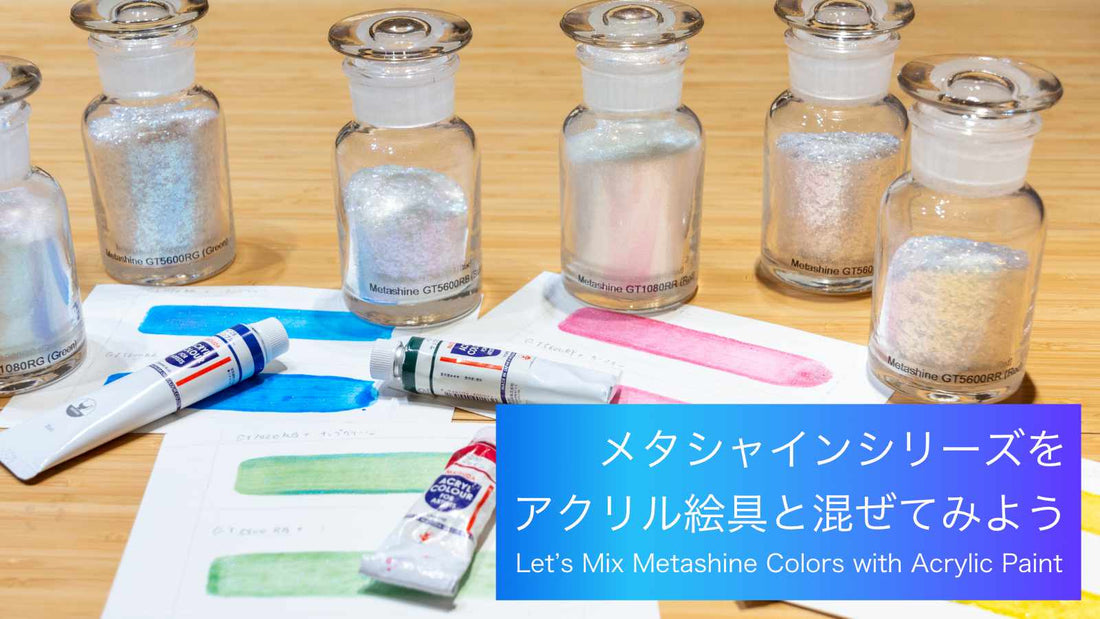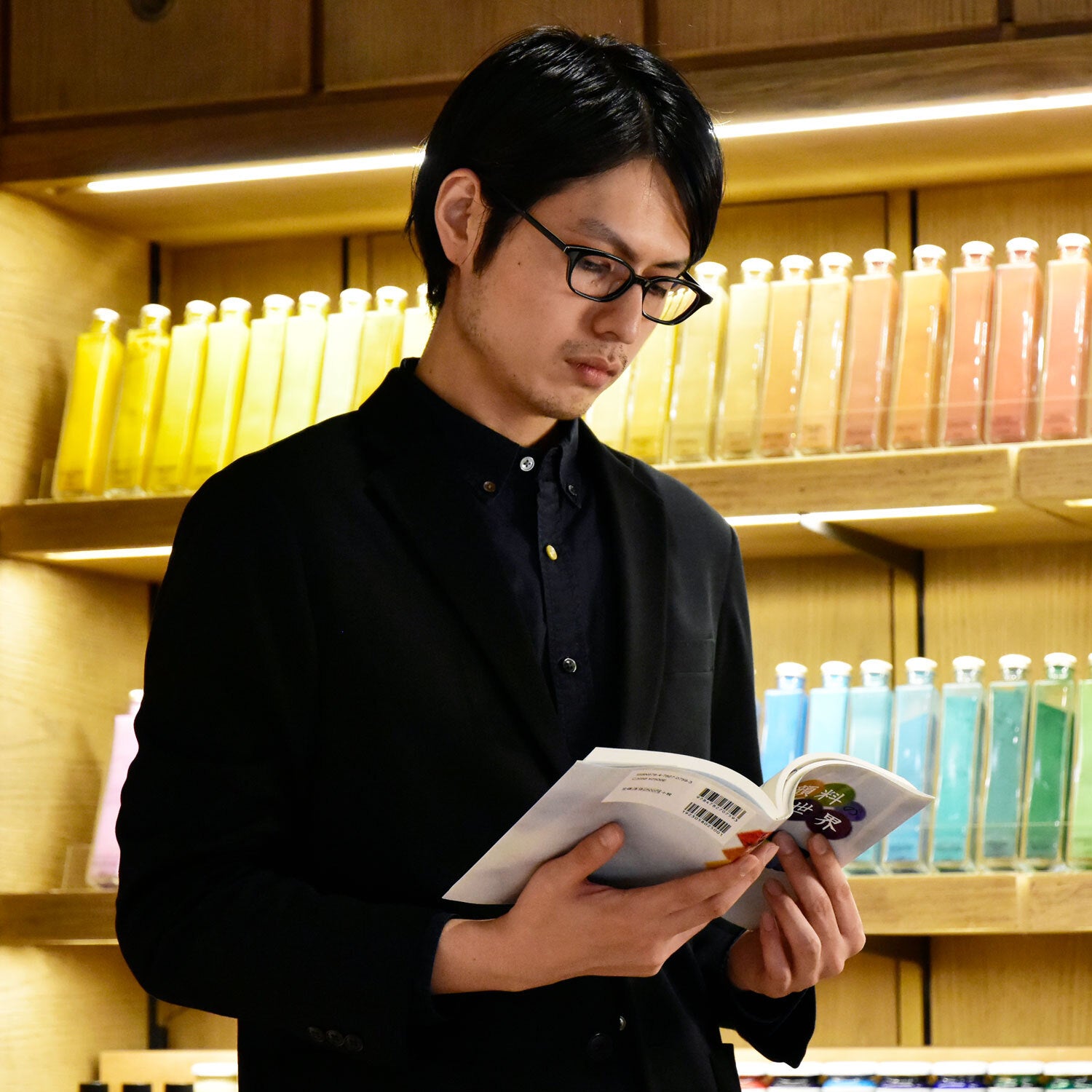Metashine is a type of inorganic pigment known for its strong luster. The base material is flake-shaped glass and its surface is coated with metal or metal oxides to produce a beautiful sheen.
PIGMENT TOKYO carries eight types of Metashine Titania Coat pigments and three types of Metashine Silver Coat pigments. In this article, I would like to focus on the Titania Coat series.
Among the eight pigments, there are two types of particle sizes and each with four colors: the finer GT1080 has Φ80µm of particle diameter, and GT5600 has Φ600µm of particle diameter.
As the picture below shows, although the glass bottles are categorized by color names such as red, blue, yellow, and green, there are seemingly not quite differences in appearance. Some of you may be wondering, “If they don’t appear as it says, why are they labeled in those color names?”
Metashine Titania Coat Pigments
From left to right, the Metashine Titania Coat GT5600 and GT1080 series are lined up.
Depending on the type of effect pigment, the color will change dramatically along with the color of the substrate, the angle of the light source, and the angle of view.
Here is a painted sample of the pigments you can also see on our online store's product page. Although the pigment powder looks like white pearl color with a reddish tint, the color turns out as below when it is painted on a black background.
Metashine Titania Coat GT1080RR (Red) is painted on white paper on the left and pained on black paper on the right.
Moreover, adding black pigment or paint to the mixture gives a similar effect to painting it on a black background too.
The following image is from the previous article in which I mixed Holbein black pigment paste with Miraval Pacific Twinkle 5402. You can see some areas are still white, which is the color of the original pigment and how the color turns out after mixing with black color.
 From PIGMENT ARTICLE “Having Fun with Effect Pigments”
From PIGMENT ARTICLE “Having Fun with Effect Pigments”
By using this color-changing characteristic, you can create new colors with acrylic paints different from what you usually get straight out of the tubes.
However, since the Metashine series is made of glass, the pigmenting power of the acrylic paints might be too strong for them.
Next, I would like to explain how we can obtain the effect with acrylic paints. I will use Gel Medium to avoid peeling due to the lack of adhesive. For GT5600, which has a large particle size, you may want to add a little more Gel Medium.
Gel Medium is a water-soluble binder for acrylic paint, since it has higher transparency than Acrylic Emulsion, allowing it to create expressions with brush strokes, layering, and paint texture.
Now let's get started with picking out the colors.
First, I will use GT1080RR (red) and GT5600 (red).
Since I wanted to create colors that can bring out the polarizing characteristic of these pigments, I mixed paints that are close to each other in the color wheel rather than triadic or complementary colors.

【Art Materials Used】
Substrate: Bamboo Washi Paper for Watercolor
Binder: Gel Medium
Colors: Metashine GT1080RR (Red), Metashine GT5600RR (Red), Matsuda Acrylic Paint Cyanine Blue
Next, I would like to try mixing bluish pigments and green paint.
This mixture creates a beautiful slight blue tint in the highlight. As with the RR (red) above, the large-particle GT5600 series produces almost no reflection and leaves a slightly rough texture. In this case, because of the Gel Medium, the larger pigment particles show through a little and a mysterious pattern emerges from the brush strokes.
If you want to obtain a solid grainy and polarized look, you will need to apply a thicker coat.

【Art Materials Used】
Substrate: Bamboo Washi Paper for Watercolor
Binder: Gel Medium
Colors: Metashine GT1080RB (Blue), Metashine GT5600RB (Blue), Matsuda Acrylic Paint Sap Green
The following samples are yellow mixed with red acrylic paint.
Some acrylic paints influence other colors while others do not so much, just like oil and watercolor paints.
The acrylic colors I chose for this article have high transparency and saturation, therefore, only a small amount of acrylic paint is needed to add. The gradation from reddish to orange in the highlights shows such good color.
Colors have beautiful highlights or lowlights depending on the paints and that could be one of the fascinating features created by mixing effect pigments and acrylic paints.
 【Art Materials Used】
【Art Materials Used】
Substrate: Bamboo Washi Paper for Watercolor
Binder: Gel Medium
Colors: Metashine GT1080RY (Yellow), Metashine GT5600RY (Yellow), Matsuda Acrylic Paint Carmine
Next, I added a yellowish green paint to the greenish Metashine. Although the color name is "olive green," this paint has more of a greenish-yellow shade.
Therefore, while the overall color is yellowish, slight GT1080RG (green) and GT5600RG (green) colors are showing throughout the entire surface.

【Art Materials Used】
Substrate: Bamboo Washi Paper for Watercolor
Binder: Gel Medium
Colors: Metashine GT1080RG (Green), Metashine GT5600RG (Green), Matsuda Acrylic Paint Olive Green
Lastly, this is the color mixture of Metashine GT5600RG (green) and Matsuda Acrylic Paint Olive Green, and I painted it thickly this time.
All the color samples in this article are painted on papers called “Bamboo Washi Paper for Watercolor”, but there is a risk of cracking of paint when coloring on paper. By applying the paint thickly to a certain degree, I was able to create a layer of rough particles of the GT5600 series over the entire surface to create a heavy texture.
However, if you plan to use the same method, I would advise you to mount the substrate to a panel or add a little more medium to prevent deterioration of the painting surfaces.

【Art Materials Used】
Substrate: Bamboo Washi Paper for Watercolor
Binder: Gel Medium
Colors: Metashine GT5600RG (Green), Matsuda Acrylic Paint Olive Green
Therefore, the effect pigments do not only change their color when applied to a black base but also have further possibilities when mixed with other paints and colorants.
Searching for saturated colors goes well with Metashine pigments by looking at the pigment bottles, paint samples, and product information brought me a more exciting experience than the usual paint-making process.
All the acrylic paints I used here are the tube paints that the medium had kneaded in already, so I could work a little more efficiently than when kneading from only pigments.
I’m sure it would be fun to try many different ways of experimenting with the polarizing effects of the Metashine series.
Translated by Atsumi Okano and Nelson Hor Ee Herng
PIGMENT TOKYO Art Materials Experts




